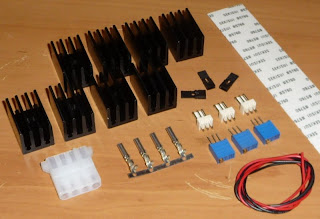Recently there have been many new people getting into sub zero cooling who still aren't quite sure how they should go about insulating a motherboard. I managed to take a few photos when preparing my new DFI board a few weeks ago and decided to whip up this quick little guide to aid anyone new to phase change (or even DICE). This is the method i use for my main rig which has been running for months without problems.
Equipment needed:
- Closed cell foam (ie neoprene). I use 6mm stuff.
- Aerotape. Basically thick, foamy insulating tape (great stuff!)
- Seal string. I hate this stuff, but it's handy.
- Conformal coating/pcb lacquer. To seal the motherboard from the devil (condensation).
- Nail Polish.
- Di-electric grease.
- Wooden skewer.
- Tracing/baking paper.
- Stanley knife.
- A motherboard + cpu is handy too!
Do not attempt to go further if you aren't happy with the fact that you're voiding your warranty. If you mod it and it dies, suck it up and buy a new one.First step is to
TEST THE MOTHERBOARD USING AIR/WATER TO ENSURE IT ISN'T ALREADY BUGGERED! This only applies of course if it's a new motherboard :).
Next, take apart the rig and transport the motherboard outside (fish aren't necessary but do make a nice background).

Now relocate away from the fish and arm yourself with a can of pcb lacquer! Make sure you're outside because last i checked, this isn't good for your lungs (or carpet). Do a couple of light coats, letting it dry inbetween. You only really need to spray behind the cpu socket area, but it's just as easy to spray the entire board. This will seal off the PCB so if any condensation does form, it can't really do anything.

Now we have the backside protected, it's time to attack the socket. To do this, we're going to whip out the nail polish. The idea is to 'paint' around the socket to protect the pcb and components much the same and the pcb lacquer on the backside. Don't be shy with this stuff, the more the merrier! Just make sure you don't get any in the cpu socket or else you've got one gnarly looking paperweight (i like to put the socket protector that comes with the mobo back in the prevent any accidents).

Grab your foam, measure the cpu socket area and mark it out. I normally use foam in a square using the edge as one side, ram slots as the second, northbridge as the third and then the mosfets as the last edge. This should be plenty unless you're going LN2 (which won't be 24/7 anyway).

Now we get out our pencil and tracing paper (baking paper works great too). Push the paper down over the cpu socket and surrounding components and trace with the pencil where everything is. Now we cut out the stencil and then transfer it to our square of foam. I don't have any pictures of this step because the DFI board i was using had nothing around the cpu socket! Excellent board to work with!
Here's a picture with the cpu socket cut out already. Pretty sloppy, but i don't really care all that much to be honest. Notice there's only two cut-outs required. One for the CPU fan and one for a capacitor.

If you haven't worked out yet, the stanley knife is bloody useful cutting this stuff (or any knife really, good luck with scissors!). For the capacitor hole, i just pierced it with a wooden skewer (the ones you might penetrate meat with to make a kebab) and then stuck a pen through the hole to make it a little bigger. This should give it just enough slack to get over the cap and form a tight seal.

Now we check that it all fits... Huzah!

Now throw the cpu in there and drop the socket lever down. It's also a good idea to put some di-electric grease under the cpu before installing. Use seal string on any suspect areas that you think might not be air-tight.

Now build up around the cpu with the Aerotape. You could also use another thin layer of neoprene, but aerotape is the shit.

Find you backing plate and cut a suitible sized square of foam for the back of the motherboard (usually the same size as the plate). Now use the wooden skewer again to penetrate through the insulation that is covering the 4 motherboard mounting holes (push through from the back... obvious to some, but you never know). Now push the 4 bolts through and check the back plate is pushed evenly against the motherboard.

Now mount that sucker! Tighten the bolts in the classic 'cross pattern'.

After mounting, loosen the bolts and check that a) your mount was even and b) there was no foam/aerotape getting between the cpu and the evap. If it's all good, re-mount and fire it up!

















